Stinging Nettle Recipe
Cooking with stinging nettle may seem unconventional, but this often-overlooked plant offers many culinary potential and health benefits. Despite its prickly exterior, stinging nettle transforms into a versatile and nutritious ingredient when handled correctly.
Foraging for stinging nettle can be an adventurous start to your culinary journey. It connects you with nature and provides access to a free, nutrient-dense green. Stinging nettle is packed with vitamins A, C, and K, several B vitamins, and minerals like iron, calcium, and magnesium.
Its earthy, slightly nutty flavor can enhance various dishes, from soups and stews to pasta and pesto. The key to cooking with stinging nettle lies in neutralizing its sting. A quick blanch in boiling water or a thorough drying process removes the stinging hairs, rendering the nettle safe to eat and easy to incorporate into your recipes.
This introduction to cooking with a stinging nettle will guide you through safely harvesting and preparing this unique plant. Whether you’re a seasoned forager or a curious home cook looking to expand your ingredient repertoire, stinging nettle will surely add an intriguing and nutritious twist to your culinary creations.
Does It Sting When You Eat It?
No, stinging nettle does not sting when you eat it, provided it is properly prepared. The stinging hairs on fresh nettles contain irritants that can cause a painful sting if touched. However, cooking, blanching, drying, or freezing nettles neutralizes these irritants and removes their sting.
Blanching is one of the most common methods used to prepare stinging nettles. By boiling the nettles for a few minutes and then plunging them into ice water, the stinging hairs are rendered harmless. After this process, the nettles can be safely handled and eaten, offering a delicious and nutritious addition to various dishes without any risk of stinging.
Why Eat Stinging Nettle In the First Place?
Stinging nettle is sought after for its impressive nutritional profile, unique flavor, and potential health benefits. Here are some compelling reasons to incorporate stinging nettle into your diet:
- Nutritional Benefits: Stinging nettle is rich in vitamins A, C, K, and several B vitamins. It’s also a good source of minerals like iron, calcium, magnesium, and potassium. Additionally, it contains a variety of antioxidants and anti-inflammatory compounds.
- Health Benefits: Stinging nettle has been used in traditional medicine for centuries due to its nutrient density. It’s believed to help with various conditions, such as reducing inflammation, alleviating allergies, supporting urinary health, and improving skin conditions.
- Unique Flavor: When cooked, stinging nettle has an earthy, slightly nutty flavor that can enhance various dishes. It can be used similarly to spinach or other leafy greens, adding depth and character to soups, stews, pastas, and more.
- Sustainability: Foraging for stinging nettle is an eco-friendly way to source food. It grows abundantly in the wild, making it a sustainable option for those looking to reduce their environmental footprint.
- Culinary Versatility: Stinging nettle can be used in numerous recipes, from traditional dishes to innovative culinary creations. It can be blended into pesto, added to smoothies, incorporated into pasta dough, or sautéed as a side dish.
By exploring stinging nettle as an ingredient, you can enjoy its nutritional benefits, experiment with its unique flavor, and contribute to sustainable food practices.
Stinging Nettle Recipe For the Brave of Mouth
Ingredients
- ¼ pound fresh stinging nettles
- 8 ounces pasta
- ½ cup olive oil extra virgin
- ¼ pound fresh ricotta cheese
- 1 lemon for zest and juice
- 1 tablespoon fresh mint chopped
- 1 tablespoon fresh parley chopped
- 1 tablespoon fresh chives chopped
- salt and pepper to taste
- 1 handful fresh sorrel leaves washed and torn into bite sized pieces
- ½ cup walnuts toasted
Instructions
- Bring two large pots of salted water to a boil. One will be for the pasta and the other for the nettles.
- When the water comes to a boil in one of the pots, "carefully" add the nettles and give them a stir. Cook for 5 minutes and transfer them to a colander with a slotted spoon. You want to leave any dirt or grit in the cooking water. Let the nettle drain.
- Add the pasta to the other pot of clean water and cook until al dente.
- While the pasta is cooking, press most of the water out of the nettles, transfer them to a food processor and puree.
- Drizzle in the olive oil and process until completely smooth.
- Add the ricotta, lemon zest and juice and herbs. Pulse the processor to blend all the ingredients.
- Season with salt and pepper.
- Remove a cup of the water the pasta is cooking in and reserve. Drain the pasta and then return it to the pot.
- Toss in the nettle ricotta cheese mixture and stir to combine.
- Add the fresh sorrel and a little of the reserved pasta water to create the desired consistency of the sauce.
- Stir in the walnuts and serve.

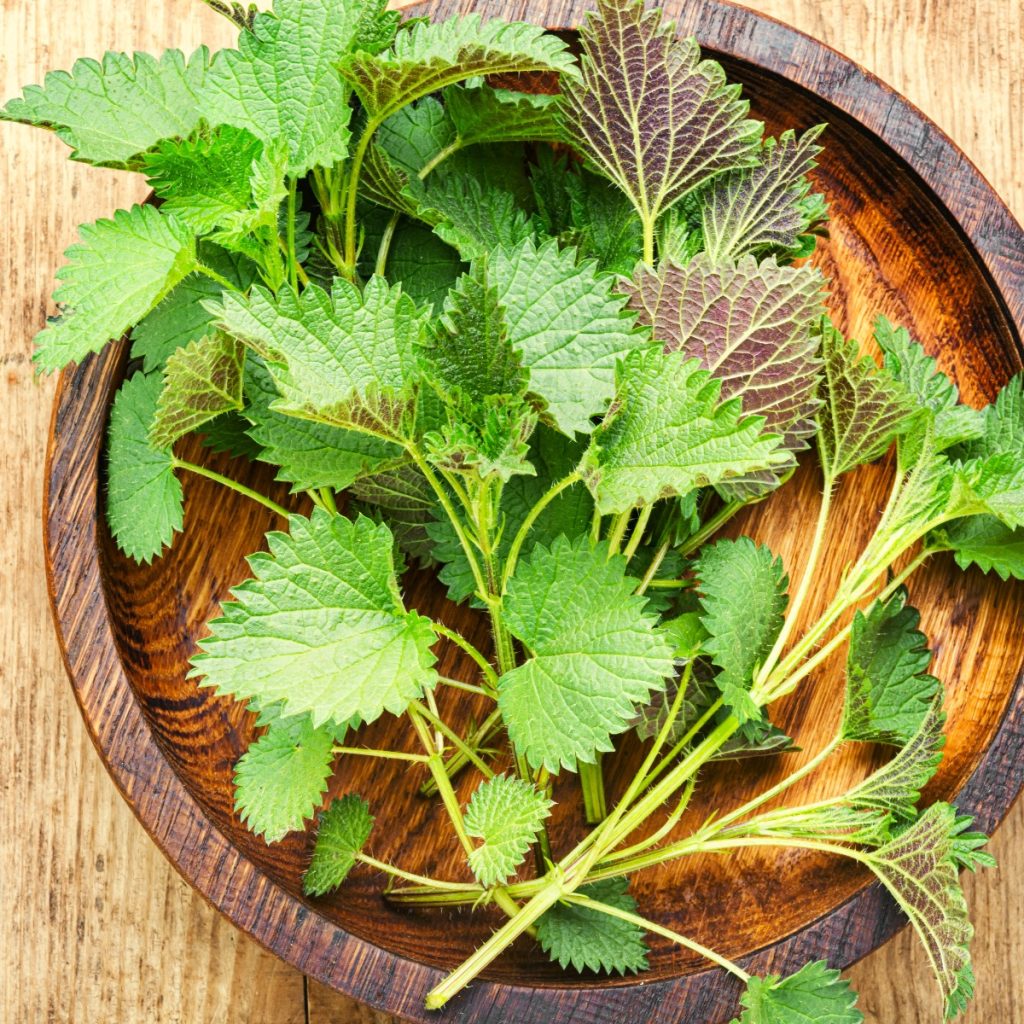




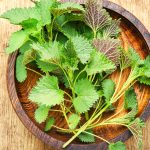

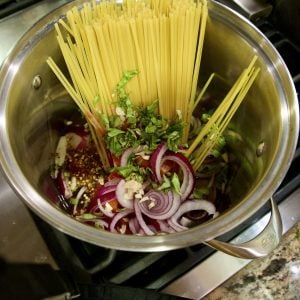
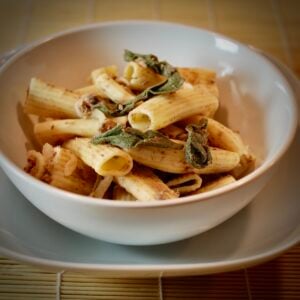

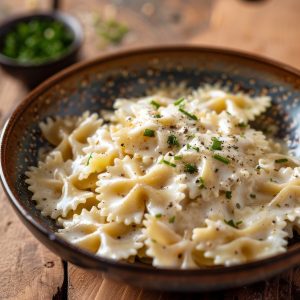
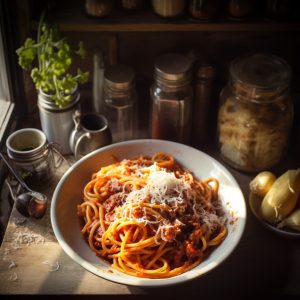

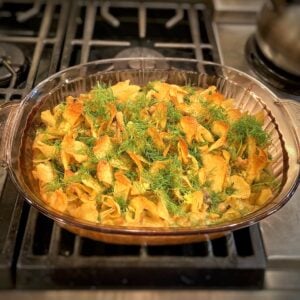


13 Responses
I was given a cookbook by my Russian mother-in-law that contains recipes for soup, dumplings, and blintzes made of stinging nettles. I’ve been told it’s good, but never tried it personally.
I just turned your recipe into a raw recipe by drying the nettle and soaking it in a little water to make the sauce. I spiraled some zucchini and marinated it for 10 hours in some Braggs liquid aminos and filtered water. I made the sauce and tossed it with the zucchini, yummy
I’ve been taking nettle tea regularly during my current pregnancy for iron deficiency. Stinging nettles are very high in iron and recommended for women, especially with low iron, to avoid or reverse anemia during pregnancy and menstruation. They are also very high in other vitamins, minerals, and vegetable proteins.
Nettles of the genus Urtica should only be used. What is commonly called “Bull Nettle” is a member of the family Euphorbiaceae; it has large leaves, very long white hairs, large white flowers and nut-like seed pods, and a milky white sap. This should not be used for food purposes except for the seed kernels. Always be sure of proper identification when harvesting wild plants.
I have heard nettles should be used before they begin to flower, and here where I am in central Texas, the nettles that have grown in a sheltered shaded area seem to have much larger leaves and take longer to go to flower than those growing in the sun. The leaves get smaller and more stemmy as the flowers set in. They can be harvested easily with leather gloves, and the spines can poke through cloth and thin rubber gloves, but I use a pair of Nyprene dishwashing gloves to wash them in the sink, sort, de-stem, and dehydrate them.
The flavor of the tea can be a bit strong and “woodsy,” but I happen to like it. Keep batches in a dark container or use it quickly, as it turns much darker green and develops a stronger flavor with exposure to light and over the course of a few hours…the chlorophyll, I guess.
Hi Katrina, thanks for sharing this information with us. – RG
hi
read your essay with interest. Remember nettles from childhood (wales uk) lots of white itchy bumps lol
where do you find them ?
they usually grow wild with a plant called burdock (not sure if that is what it is called here ) the remedy for white itchy bumps was to rub the leaves of burdock on them to take the sting out i would like to see them again
thanks gaynor reynolds nether providence pa
Hi Gaynor, the nettles from this post were found on Harriton Farms in Bryn Mawr, PA. Thanks for the suggestions. – RG
Hello, I’m Gopal from Nepal. We have a company to produce the powder of stinging Nettle. I got pleasure reading your articles and methods of cooking. Let us know if we can help you from Nepal. We are using 100% natural products, so it’s organic. Sadhana Nepal Industry – Butwal,Nepal
Hi Gopal, thank you for this information – RG
Some growers here in Southern California are now selling nettles and local farmer’s markets, but the only use they seem to know is for herb teas. In Ireland and Northern and Eastern Europe, they are used for soup. I’ve put two very nice soup recipes on my (currently non-commercial) food website at http://www.clovegarden.com/recipes/bov_nettle1.html (Irish) and http://www.clovegarden.com/recipes/vov_nettle1.html (Swedish)
Hi Andrew, thanks for sharing these recipes with me. I’m sure they taste better in your soup than eating them raw. – RG
I am making a bazzi ie fried garlic and onions,1 teaspoon of haldi powder then mix in the boiled chopped nettles add salt to taste a chili or two eat with rice very nice.
Thanks Pat. Wasn’t sure what you were saying but I looked up haldi and found out it is another name for turmeric. Are you saying bazzi is fried garlic and onions? – RG
The dried,seived nettle leaf is so versatile in giving ‘body’ to gravies,soups,sauces,that we wouldn’t be without it.
This and kelp powder..
Hi I have enjoyed nettle drink in the past for years. Now I am too lazy to go harvest in the paddock 11kilometers away. Pick tops of fresh young plants rise with water and put into a stainless steel pot or ceramic container pour boiling water over it to one thumb past the leaves. When cool put in fridge and wait 24 hrs. Whether or not it the water turns to a beautiful blue green color it is a wonderful refreshing drink and you can eat the leaves afterwards.
Cheers
PS I am seriously thinking of getting it again as my sciatica is back again.
Last week I found some stinging nettles in my backyard in southern California. A lovely, bright green plant I’d never seen before suddenly started growing in an unplanted pot full of rich compost and soil. I stopped to admire the pretty leaves, crushing one to see what it smelled like; of course, it gave me sharp stings and a not-too-terrible rash for a day.
My next-door neighbors, who are originally from France, positively identified them as well as my comparing them to your photo. The mom says it is everywhere where their family lives in France, and it is easy to brush your legs against it. The daughter says the soup is YUMMY. She also offered that the stinging toxin can be neutralized with vinegar if your skin is irritated.
The son will take a specimen for his high school plant collection; maybe it will be the crown jewel of the class.
Thank you for the recipe. I don’t know if we will have enough of the plant to cook with it, but it’s growing quite fast!